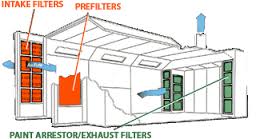Anatomy of a Cross Draft Paint Spray Booth
What is a cross draft paint spray booth?
The cross draft spray booth has two major functions: provide a clean working environment for paint refinishing, and efficiently remove paint overspray from the booth.

How does a cross draft paint booth work?
The cross draft spray booth works by drawing air horizontally over the object to be painted. Typically, air is drawn directly from the shop environment through filters located within the doors of the spray booth. These filters are known as intake panel filters (Series 65 or ZR-1). It should also be noted that some cross draft spray booths incorporate air make-up systems which draw air from an air make-up units typically located on the top of the spray booth. In this case, the spray booth would have solid doors and the intake filters would be positioned on the left and right hand sides of the booth.
Paint overspray is exhausted through exhaust filters / paint arrestors. The major function of the exhaust filters / paint arrestors is to efficiently remove and collect paint particles as they are exhausted up through the exhaust stack. Exhaust filters are also critical to prevent paint buildup in the exhaust system, such as in fans and ducts, and reduce the potential for mechanical breakdown.

Some helpful hints for quality finishes are:
- Run your spray-booth several minutes before painting and this will clean the painting chamber of any residual paint damaging particles, especially those particles that may have entered the paint booth when the booth is opened and closed.
- Wash down you booth as part of your monthly maintenance program.
- Ground the article being painted to eliminate static electricity.
- Wear non-linting coveralls while painting.
- Properly maintain door gaskets.
- Constantly review incoming compressed air.
- Insure hoses and spray guns are dirt free.




